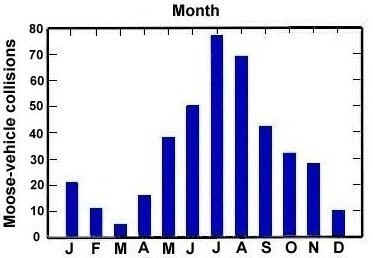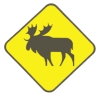People have been killed in moose vehicle collisions. More often they are injured, resulting in hospitalization, time off work, and loss of pay. Cost estimates for vehicle damage alone are more than $1 million annually.
- Why Moose use Roadways
- Prevention
- Accident Occurrences
- How to Avoid an Accident
- Moose Advisory – Department of Transportation and Works
Why Moose use Roadways
Roadways often run through areas of prime moose habitat. More importantly, roads tend to attract moose which come there to:
- feed on the vegetation along the roadside;
- gain relief from flies in the open windswept right-of-ways;
- in winter, to travel roadways cleared of deep snow.
- or simply to move from one part of the habitat to another
Prevention
As long as there are moose in Newfoundland, they will be found on the highway. Data show that even in areas with very low moose density, moose are still attracted to roadways and can pose a hazard to drivers
Whistles, reflectors, and odour repellents to frighten big game from passing vehicles or keep them from roadsides have been tested in North America and Europe; so far none have proven to be effective or economically feasible.
Care and attention when driving remains your best defence against a moose-vehicle accident.

Moose-Vehicle Collisions
Accident Occurrences
While accidents are reported year round, more than 70% occur between May and October. The three most critical months are June, July, and August.
The majority of accidents occur between dusk and dawn. This is the time when driver visibility is severely limited by darkness, and when moose are most active. Most accidents occur on clear nights. So to avoid an accident, when you drive, think Moose!

Most of the Provincial highway system runs through good moose habitat. Thus, a driver can expect to encounter moose while travelling on any section of the Trans Canada Highway (TCH) or on any secondary roads.
Many accidents occur on straight stretches of roadway.
More accidents occur on certain sections of roadway. These HIGH-RISK areas are marked with moose crossing warning signs as illustrated.
How to Avoid an Accident
- Slow down when driving at night. This will allow you more time to respond to a moose on or near the highway.
- Pay attention to Warning Signs; they mark High-Risk areas. These signs were placed along the roadways for you! Slow down and watch for moose.
- Scan both sides of the road ahead as far as possible, especially when you are in a posted High-Risk accident zone.
The best way to avoid an accident is to spot the moose well in advance. Drivers report that in most accidents they did not see the moose until immediately before impact.
Moose on the right side of the vehicle are avoided more often than those on the left because drivers concentrate more on the right. Therefore, it important to scan both sides of the road. - Use extreme caution whenever you see an animal. No matter what it appears to be doing or how far it is from the road, slow down.
- Moose are unpredictable. The moose you see standing calmly at the edge of the road could bolt in front of your vehicle at the last moment.
- Don’t let yourself be distracted. A driver who is alone and concentrating on the road is less likely to strike a moose, than is a driver whose attention wanders while talking to a passenger.
- Remember most accidents occur on clear nights and on straight road sections, maybe because drivers are more cautious on curves or in poor weather.
- Keep your windshield and headlights clean.
- Drive with your headlights on high beam unless approaching, or overtaking, other traffic.
- Wear your seat belts. Seat belts save lives.
